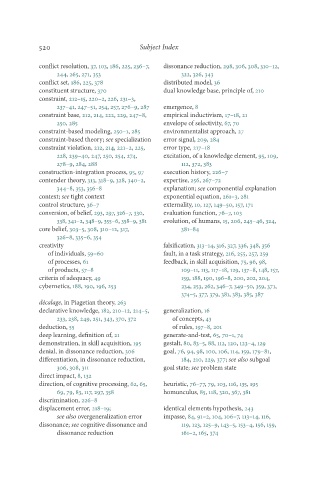Page 537 - Deep Learning
P. 537
520 Subject Index
conflict resolution, 37, 103, 186, 225, 236–7, dissonance reduction, 298, 306, 308, 310–12,
244, 265, 271, 353 322, 326, 343
conflict set, 186, 225, 378 distributed model, 36
constituent structure, 370 dual knowledge base, principle of, 210
constraint, 212–15, 220–2, 226, 231–3,
237–41, 247–51, 254, 257, 276–9, 287 emergence, 8
constraint base, 212, 214, 222, 229, 247–8, empirical inductivism, 17–18, 21
250, 285 envelope of selectivity, 67, 70
constraint-based modeling, 250–1, 285 environmentalist approach, 27
constraint-based theory; see specialization error signal, 209, 284
constraint violation, 212, 214, 221–2, 225, error type, 217–18
228, 239–40, 247, 250, 254, 274, excitation, of a knowledge element, 95, 109,
278–9, 284, 288 112, 372, 383
construction-integration process, 95, 97 execution history, 226–7
contender theory, 313, 318–9, 328, 340–2, expertise, 256, 267–72
344–8, 353, 356–8 explanation; see componential explanation
context; see tight context exponential equation, 261–3, 281
control structure, 36–7 externality, 10, 127, 149–50, 157, 171
conversion, of belief, 293, 297, 326–7, 330, evaluation function, 76–7, 103
338, 341–2, 348–9, 355–6, 358–9, 381 evolution, of humans, 15, 206, 245–46, 324,
core belief, 303–5, 308, 310–12, 317, 381–84
326–8, 335–6, 354
creativity falsification, 313–14, 316, 327, 336, 348, 356
of individuals, 59–60 fault, in a task strategy, 216, 255, 257, 259
of processes, 61 feedback, in skill acquisition, 75, 96, 98,
of products, 57–8 109–11, 113, 117–18, 129, 137–8, 148, 157,
criteria of adequacy, 49 159, 188, 190, 196–8, 200, 202, 204,
cybernetics, 188, 190, 196, 253 234, 253, 262, 346–7, 349–50, 359, 371,
374–5, 377, 379, 381, 383, 385, 387
décalage, in Piagetian theory, 263
declarative knowledge, 182, 210–12, 214–5, generalization, 16
233, 238, 249, 251, 343, 370, 372 of concepts, 43
deduction, 55 of rules, 197–8, 201
deep learning, definition of, 21 generate-and-test, 65, 70–1, 74
demonstration, in skill acquisition, 195 gestalt, 80, 83–5, 88, 112, 120, 123–4, 129
denial, in dissonance reduction, 306 goal, 76, 94, 98, 100, 106, 114, 159, 179–81,
differentiation, in dissonance reduction, 184, 210, 229, 377; see also subgoal
306, 308, 311 goal state; see problem state
direct impact, 8, 132
direction, of cognitive processing, 62, 65, heuristic, 76–77, 79, 103, 116, 135, 195
69, 79, 83, 117, 297, 358 homunculus, 85, 118, 320, 367, 381
discrimination, 226–8
displacement error, 218–19; identical elements hypothesis, 243
see also overgeneralization error impasse, 84, 91–2, 104, 106–7, 113–14, 116,
dissonance; see cognitive dissonance and 119, 123, 125–9, 143–5, 153–4, 156, 159,
dissonance reduction 161–2, 165, 374

